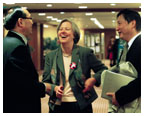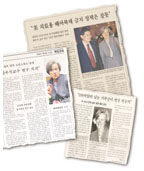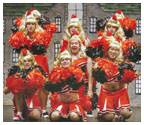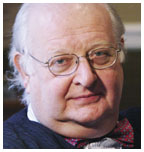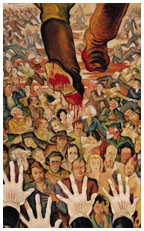December 8, 2004: Notebook
University delegation works to increase visibility
Small departments, major marketing
Student drowns during fall break
From left, Ruogu Li *84, President Tilghman, and Austin Hu *95 at an alumni gathering in Beijing. (Eva Lerner-Lam ’76)
President Tilghman made headlines in Asia, including these in the Korean newspapers, from left, the Mae-il Economics Daily, Chosun Daily, and the Joong Ang Daily. The top headline spotlights Tilghman’s views on stem-cell research. |
Princeton
in Asia
University delegation works to increase visibility
While students were on fall break, President Tilghman and other University administrators went on an 11-day, four-city tour of the Pacific Rim, where they met with alumni, reached out to schools and colleges, and sought to bolster international applications by meeting potential students and increasing Princeton’s visibility.
Among the travelers, in addition to Tilghman, were Dean of Admission Janet Rapelye; Dean of the Graduate School William Russel; Alumni Council Director Margaret Miller ’80, and Professor Miguel Centeno, director of the Princeton Institute for International and Regional Studies. Together and individually they visited Tokyo, Beijing, Hong Kong, and Seoul; in each city, they had meals or “town-hall meetings” with alumni, visited with secondary-school students and guidance counselors, and met with officials at various universities, aiming to establish new relationships or cooperative programs.
While Asian students make up a small portion of undergraduates, they comprise almost 15 percent of all graduate students. The largest group, 207 students, is from China. But recent changes in visa requirements and processing, as well as the growing number of high-quality alternatives for students abroad, have made it more difficult to attract international students to American universities.
At virtually every stop, Tilghman gave interviews to major newspapers and television shows, including, in Beijing, two hugely popular shows that resemble Oprah and 60 Minutes. Her topics ranged from Princeton and higher education, to being a woman scientist, to stem-cell research. She drew much media attention in Korea for her meeting with scientists including Hwang Woo-Suk, who leads an embryo-cloning research team at Seoul National University. At that meeting, Tilghman, a molecular biologist, supported Hwang’s efforts in therapeutic cloning — cloning aimed at finding treatments for now-incurable diseases. (She said she opposed human reproductive cloning.)
In Hong Kong, the visitors participated in a conference that included a panel discussion, “Princetonian Reflections on the Global Marketplace” with alumni Gordon Wu ’58, Louise Sams ’79, and Andrew L. Tung ’87.
The Princeton group drew large crowds in Seoul. Korean students are less familiar with Princeton than with places such as Harvard and the Massachusetts Institute of Technology, said YoungSuk Chi ’83, who helped organize the trip. The chance to see that Tilghman — a scientist, a woman, and a foreigner (she’s from Canada) — was chosen to lead a top American university impressed many Koreans, he said.
Participants described the trip as a success, with strong attendance
at events, significant media attention, and valuable new contacts made.
At the Rendafuzhong School in Beijing, Tilghman did her part for international
good will by accepting the principal’s challenge to a friendly game
of table tennis, drawing cheers from the students. (She lost.) “It’s
one of my favorite memories from the trip,” Rapelye said.![]()
By. M.B.

ACADEMIC DEPARTMENTS WITH Department Current juniors and seniors Slavic languages/literatures 6 German 8 Astrophysical sciences 9 French and Italian 14 Spanish and Portuguese languages/cultures 14 Source: Office of the Registrar |
Small departments, major marketing
Princeton freshmen and sophomores have a new reading assignment to complete before choosing their major. “Major Choices,” a 71-page booklet published by Dean of the College Nancy Weiss Malkiel and the communications office, encourages students to follow their intellectual passions, even if they don’t seem immediately relevant to their career plans.
“Major Choices,” part of an effort to draw students to smaller departments, shares stories of alumni who majored in some of those departments. About 43 percent of current juniors and seniors concentrate in the University’s five largest departments — politics, history, economics, the Woodrow Wilson School, and English. With 29 other departments ready and willing to take more concentrators, Malkiel is working to find creative strategies to attract students. Some departments have changed the way introductory courses are taught, while others are reaching out to what Malkiel calls their “natural constituencies.” Career Services and the residential colleges also have joined in the effort, hosting programs that introduce underclass students to upperclass students and alumni who majored in the smaller departments. “There aren’t any specific numerical targets,” Malkiel says, “but I would hope to see the percentage of students in the five largest departments decline over time.”
Contributors to “Major Choices” include East Asian studies major J.D. Delafield ’89, who founded an investment bank, geosciences major Sarah Hougen Poggi ’92, an assistant professor of obstetrics and gynecology, and Slavic languages and literatures major Boris Fishman ’01, who is as an editorial staffer at the New Yorker.
Students in the process of choosing a major gave mixed reviews. Rahul
Mehra ’07, who plans to study economics, worries that the University
is promoting smaller departments at the expense of the larger ones, while
for Danny Shea ’07, who lists the Wilson School and economics as
his top choices, the book was encouraging. “It spoke to me about
going where you want to go,” Shea says. “But my interests
are in economics and policy, so it just confirmed my decision to follow
those majors.” ![]()
By B.T.

Health report
Increased staffing for University Health Services and improvements to mental-health coverage in the Student Health Plan top the list of more than 40 major recommendations in the final report of the University’s Task Force on Health and Well-Being, published Nov. 9. The report also recommends facility upgrades at McCosh Health Center and Dillon Gymnasium, and the expansion of child-care services.
The report recommends adding what amounts to 11 full-time positions to the University Health Services staff to help reduce waiting times, expand hours, and meet “significant, growing, and too-often unmet demands,” particularly in mental-health and urgent outpatient care. An increase of $300 to $400 in the Student Health Plan fee could finance some of the staff additions. (The health plan enrolls all graduate students and about 45 percent of undergraduates.)
The final report is available at www.
princeton.edu/hwbtf/reports.shtml. ![]()
By B.T.

(Photo by Frank Wojciechowski) |
The Princeton Triangle Club performed its 114th annual show, “Orange
and Black to the Future” for three performances at McCarter Theatre
in mid-November. In the traditional all-male kickline, above, a motley
group of cheerleaders shows its spirit. ![]()

Professor Angus Deaton rejects the notion that globalization has been bad for the world’s poor. (Photo by Frank Wojciechowski) |
More than 1.1 billion people live on less than $1 a day, according to the World Bank’s latest measures of extreme poverty. The number seems staggering, especially to Americans who spend more than that on a cup of coffee. But what does a dollar buy in the Third World? And what do poverty rates tell us about future prospects for the world’s poor?
Calculating poverty is tricky business, according to economics and international affairs professor Angus Deaton. “It’s actually harder than you might think to say who’s poor and who’s not poor,” he says, “especially when you’re comparing the living standard of a poor person in Harlem with that of a peasant in Ethiopia, for instance.” There are technical issues, such as converting the relative purchasing power of foreign currencies, and political obstacles, particularly on the national level, where most anti-poverty policy is enacted.
Truth in measurement, Deaton says, is immensely important because it can show whether current antipoverty measures are working. Extreme poverty has declined in the last 20 years, based on the controversial World Bank figures, but key questions remain: What is the best way to address poverty? Is it a simple matter of promoting economic growth? Should health care, public health, and education be considered as well?
Deaton, who has studied poverty for much of his career, has taken a particular interest in the relationship between health and poverty, working in conjunction with the Woodrow Wilson School’s Center for Health and Wellbeing. His publications include a paper on health in the age of globalization, an examination of inequality and mortality rates in the U.S., and a study of health-care delivery in the rural area of Rajasthan, India.
In Deaton’s work, one common finding is that health and poverty are not perfectly aligned. The United States, despite its wealth, barely makes the top 20 in world rankings of life expectancy. In India and China, economic growth has been rapid in the last two decades, but health indicators in China, such as life expectancy and infant mortality rate, have not progressed as significantly as those in India, even when China experienced more growth.
Health knowledge plays a role in global poverty, according to Deaton. As rich countries have shared knowledge about health and technology, adult mortality rates in those countries have converged. “Globalization would do much for global health if transmission [of knowledge] from rich to poor countries could be accelerated,” he writes.
But health care’s importance is just a small part of the antipoverty policy debate. Every viewpoint in the world poverty debate has a nongovernmental organization (NGO) to support it, Deaton says, and they can’t all be right. He tries to take a balanced view. In an article about global economic inequality, the Economist called Deaton “perhaps the only economist at work in this area who is acknowledged by all sides both as authoritative and as having no ideological axe to grind.” Deaton refutes the idea that growth and globalization have been bad for the world’s poor, highlighting India and China as examples of poverty alleviation, pointing out that many nations, including those in sub-Saharan Africa, have been left behind.
“I get pilloried from both the right and the left for getting
this wrong, and I think if that’s not happening, I’m probably
not doing this thing right,” Deaton says. “I try to call it
the way I see it.” ![]()
By B.T.

“The Dickensian city, the great, rotting metropolis, felt exactly like the stuff outside the window in Bombay and Calcutta, and I thought you could apply everything that Dickens said about the 19th-century city in England to the 20th-century city in India.”
Novelist Salman Rushdie speaking about “The Novel and the City”
in a Nov. 11 lecture sponsored by the Shelby Cullom Davis Center for Historical
Studies. Rushdie reminisced about the Bombay of his childhood, “a
brash, commercial, largely superficial, and tremendously enjoyable”
city. ![]()

For the last four semesters, Vanessa Wu ’06 has been working on campus with the Conversation Partners program, which matches one undergraduate with two international graduate students to give the graduate students a chance to ask questions and improve their speaking skills. In their first meeting this year, Wu’s students, from China and South Korea, inquired about the structure of American government and the role of states. Wu explained that states can make their own laws. In New Jersey, for instance, state law prohibits drivers from pumping their own gas, but that’s not the law in California.
“They thought that was absurd,” Wu says. It wasn’t the gas-pumping law that concerned them, but the idea that local government can make its own laws. Coming from nations with strong central governments, the graduate students wondered how such a disorganized country could function.
Understanding American government is just the beginning. The grad students want to know about high schools in the United States, the lifestyle of undergraduates, Princeton’s residential colleges, the eating clubs, and common American idioms. The questions may seem trivial, but they are invaluable for Princeton’s future preceptors.
Conversation Partners is part of the University’s English-language program, which is mandatory for aspiring teaching assistants who do not meet Princeton’s stringent English proficiency standards. Three hours of weekly classroom instruction, in groups of 10, make up the bulk of the program, helping students with presentation skills, pedagogy, and vocabulary. But practicing conversational English in smaller groups is also important, according to Bobbie Thompson, the program’s director. It teaches graduate students how to communicate with undergraduates, which improves the quality of teaching.
Undergraduate conversation partners work for a small stipend, and periodically give feedback on teaching presentations, in preparation for the end of the semester, when the graduate students have to pass an oral teaching exam. But for the most part, the discussions are casual, and often educational. Krista Brune ’06, who has been a conversation partner since the program began three years ago, says she has learned about the homelands of her partners — India, China, South Korea, Japan, and Vietnam — as well as the work that they do. “They love to talk about their research,” she says.
Graduate students give the program strong reviews. In a survey conducted after the fall semester last year, 56 of 60 participants said the program was a positive experience. “It was very helpful, maybe the most helpful part of the English program,” says Yingying Fan, a graduate student in operations research and financial engineering. Classroom in-struction provided fundamental language skills, she says, but Conversation Partners gave her a chance to practice them.
Since undergraduates and graduate students rarely have a chance to interact
outside the classroom, Conversation Partners can be an eye-opener for
both sides. “They have so much to offer each other,” Thompson
says. “The undergraduates get as much out of it as the graduate
students.”![]()
By B.T.

Illustration
by
Steven Veach
Head games
Choices between short-term and long-term rewards often reveal inconsistencies in reasoning. Why does it happen? According to Jonathan Cohen and Samuel McClure of Princeton’s Center for the Study of the Brain, two parts of the brain compete in the decision-making process. In the Oct. 15 issue of Science, Cohen, McClure, and researchers from Harvard and Carnegie Mellon presented brain-imaging results from a study of 14 Princeton students who were asked to choose between Amazon.com gift certificates ranging from $5 to $40. To receive larger amounts, the subjects had to wait, in some cases up to six weeks, while smaller amounts were available earlier. When choosing short-term rewards, the students showed a heavy influence of neural systems associated with emotions. Long-term choices called on brain systems associated with abstract reasoning. The study has applications in neuro- oeconomics, the study of mental and neural processes that drive economic decision-making, and health issues such as drug addiction. Ultimately, the researchers hope to understand how the brain decides whether emotion or reasoning takes precedence.
Urban fever
Malaria, a disease once found almost exclusively in rural tropical regions,
is creeping into the cities of sub-Saharan Africa, creating a significant
threat to urban residents. According to professor Burton Singer and researcher
Maria Caldas de Castro of the Office of Population Research, 200 million
people, or about a quarter of the total African population, live in urban
settings that cover less than 2 percent of the continent’s surface.
Urban sprawl has created new breeding grounds for the mosquitoes that
transmit malaria, and city dwellers often have a lower resistance to the
disease. Singer, de Castro, and three colleagues recently published a
paper in the American Journal of Tropical Medicine and Hygiene recommending
early diagnosis and early treatment, as well as preventive measures and
environmental management to reduce the risk of an epidemic. ![]()

(From the Sylvia Beach Papers, Manuscripts Division, Department of Rare Books and Special Collections, Princeton University Library) |
“Derso & Kelen: Cartoons & Caricatures,” an exhibition on display in Firestone Library's Milberg Gallery, highlights political cartoons, portraits, magazine illustrations, and limited-edition portfolios by artists Emery Kelen and Alois Derso. Like the work shown here, which comments on the plight of Jewish refugees in Europe, the illustrations portray political events between 1920 and 1950. The exhibition includes depictions of delegates attending the numerous economic and peace conferences after World War I, the activities and proceedings of the League of Nations, the rise of Adolf Hitler, and the devastation of World War II. The exhibition runs through March 20, and the gallery is open from 9 a.m. to 5 p.m. on weekdays and from noon to 5 p.m. on weekends.
“Bringing into Being: Materials and Techniques in American Prints 1950–2000,” continues on exhibit at the Princeton Art Museum through Jan. 9, 2005. The show contains 31 prints from the University’s collection, ranging from Milton Avery’s monotype Green Sea to woodcut illustrations and a carved slipcase by sculptor Martin Puryear. Admission is free. The exhibition is open Tuesday to Saturday from 10 a.m. to 5 p.m.
Henry Petroski,
who has been called “America’s poet laureate of technology,”
will deliver a series of lectures titled “The Design of Everything:
From Success to Failure,” beginning Wednesday, Dec. 8, and continuing
the next two nights. Petroski, a professor of civil engineering and history
at Duke University, has written on subjects ranging from pencils and paper
clips to bridges. His first lecture at Princeton is subtitled “Small
Things;” his second, “Large Things;” and his third,
“Future Things.” All three lectures will begin at 8 p.m. in
McCosh 50 and are free and open to the public.
![]()

Student drowns during fall break
Sophomore Alan Ebersole drowned Oct. 29 off the coast of South Florida while on a trip with the men’s and women’s swimming and diving teams. Ebersole, 20, from Vicksburg, Miss., was reported missing by teammates after a late-night swim at about 10:30 p.m. Broward County sheriff’s deputies searched for more than an hour before locating Ebersole’s body three-quarters of a mile away. He had suffered a broken neck due to blunt trauma, but the cause of death was not immediately known and a complete autopsy report was not expected for several weeks.
The Class of 2007 held a memorial in the Princeton chapel Nov. 3 for
Ebersole and classmate Melissa M. Huang, who died on campus earlier this
semester. Class officers distributed orange and black lapel ribbons, similar
to the familiar pink breast-cancer ribbons, to honor the two sophomores.
“We wanted people to look up from their studies and realize that
there is more going on in the world,” said class president James
Williamson ’07. ![]()

Thomas Kean ’57, who chaired the bipartisan commission that investigated the September 11 attacks, and Nathan MyHrvold *83, former chief technology officer at Microsoft, will receive the University’s top honors for alumni.
On Alumni Day, Feb. 26, Kean will receive the Woodrow Wilson Award, given to an undergraduate alum, while Myhrvold will receive the Madison Medal, given to a graduate alum.
Kean, president of Drew University, was governor of New Jersey from 1982 to 1990. Myhrvold is co-founder and chief executive officer of Seattle-based Intellectual Ventures, which is focused on the funding, creation, and commercialization of inventions. He is also known for his philanthropic work with various children’s, educational, and civic organizations.
Several Princetonians seeking office around the country enjoyed success on Election Day. Republican Christopher “Kit” Bond ’60 of Missouri won a fourth term in the United States Senate while Representative Jim Leach ’64 was reelected to a 15th term in the House of Representatives from Iowa’s second district. Republican Mitchell Daniels ’71, former director of the Office of Management and Budget, was elected governor of Indiana.
Another week, another ranking. A recent survey by the Times of London’s Higher Education Supplement placed Princeton ninth among all world universities. The listing, based on the views
of 1,300 academics in 88 countries, ranked universities on five criteria, including strength of teaching, research, and international reputation. Harvard topped the list, followed in order by UC—Berkeley, MIT, Cal Tech, Oxford, Cambridge, Stanford, Yale, Princeton, and ETH Zurich.
The University turned over the deed for 10 acres of property
in South Brunswick Township to the Mapleton Preserve on Nov. 1, beginning
the transfer of 134 acres that will become part of an open-space buffer
for the Delaware and Raritan Canal and the village of Kingston. In addition
to the land, which was purchased from Princeton Nurseries 18 years ago,
the University has committed $100,000 to the preserve’s educational,
horticultural, and historic-preservation programs. ![]()

In memoriam
Edward T. Cone ’39 *42,
pianist, composer, member of the Council of the Humanities, and professor
of music at Princeton from 1946 until his retirement in 1985, died Oct.
23 from complications following heart surgery. He was 87. Salutatorian
of the class, he was also the first Princeton undergraduate to have an
original music composition accepted as a senior thesis and was one of
the University’s first recipients of a master of fine arts in music
degree. ![]()


